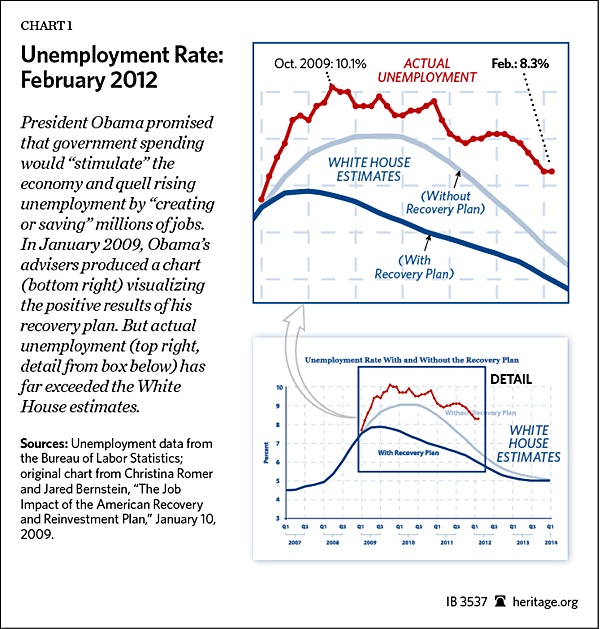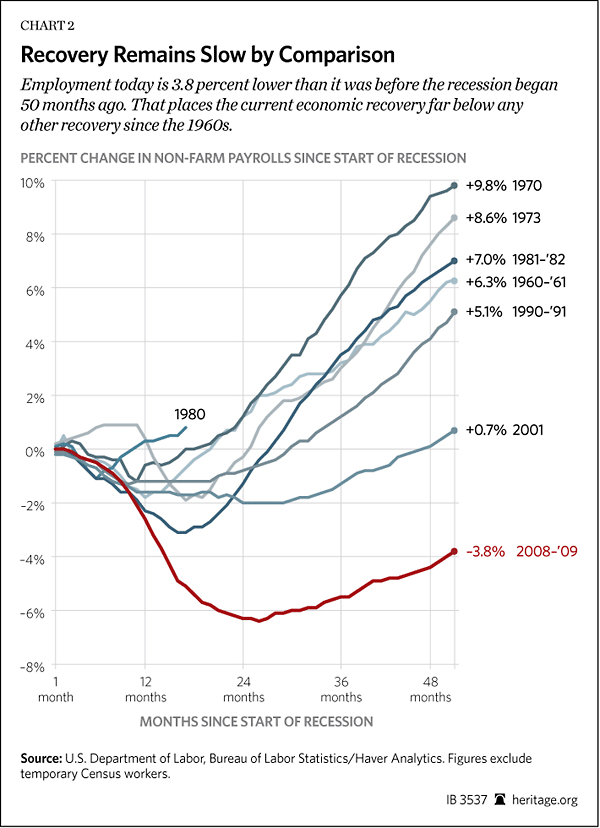The Bureau of Labor Statistics has reported that businesses and governments increased payrolls by 227,000 jobs in February and that the unemployment rate remained at 8.3 percent. The unemployment rate remained flat even as the labor market increased by 476,000 potential workers. Job creation was robust enough that the labor market absorbed these new workers without an increase in the unemployment rate. There were also other positive signs of job growth throughout the February report.
However, the economic recovery continues to be slower than previous recoveries, and better policies are needed to return economic activity to its full potential.
The February Report
In February, the labor market saw 233,000 new private-sector jobs and 6,000 fewer government jobs. The job numbers for December and January were revised upward by 61,000 jobs. While construction (–13,000) and retail trade (–7,400) shed jobs, most other sectors saw job growth. Manufacturing (31,000), leisure and hospitality (44,000), health care (61,100), and professional and business services (82,000) had some of the strongest job growth. Temporary services, part of business services, grew sharply (45,200), which bodes well for continued job growth in the next few months.
The unemployment rate was unchanged at 8.3 percent. Alternative measures of unemployment did fall, with the broadest measure of unemployment falling from 15.1 percent to 14.9 percent.

The past three jobs reports show average job gains of 250,000 per month and have been an improvement over months of dismal jobs numbers. As a consequence, the duration of unemployment has dropped. In February, the number of long-term unemployed workers fell by 92,000. The median duration of unemployment fell from 21.1 weeks to 20.3 weeks, the lowest level since September 2010. The mean duration fell to 40 weeks, the lowest level since last October.
There are other signs of labor market tightness, with an increase in the weekly hours of work for production and non-supervisory employees to 33.8 hours a week, the highest since 2008. Their average wages increased as well, to $19.64 an hour.
Labor Force Participation Improves
The labor force participation rate rose by 0.2 percentage points to 63.9 percent. This is why unemployment stayed flat even as employers created jobs. This is good news. Labor force participation fell by more than 2 percentage points since the start of the recession,[1] and millions of potential employees stopped even trying to find work. Increased labor force participation suggests that those workers believe they can now find jobs.
However, the February improvement largely reflects a bounce back from a curious drop in labor force participation rates in the late fall. In November, the participation rates of adult women dropped by 0.3 points, while the participation rates of adult men remained flat. Analysts suggested this may have been a statistical anomaly.[2] In February, the labor force participation rates of adult women increased by 0.3 percentage points, while the participation rate of men remained flat. The participation rates of both sexes are now at the same level as in the early fall.[3] The February improvement, then, probably reflects a statistical correction in the data.
Labor force participation remains at the lowest levels since the mid-1980s—a time when far fewer women worked. Until the employment reports show a sustained increase in participation rates, the economy will be weaker than the unemployment rate suggests.
Slow Recovery
In the context of an already good economy, February’s employment figures would be excellent news. In the context of the recovery from the worst recession of the postwar era, they are only encouraging. Certainly, job growth is better than continued stagnation, but the U.S. economy has great underlying resilience. It will eventually recover from a recession. The important questions are how long until that happens and how quickly the economy grows.
Job creation usually surges after a deep recession as entrepreneurs and investors find new productive work for the unemployed. For example, unemployment rose to 10.8 percent in the 1981–1982 recession. After that recession ended, hiring boomed. Within a year of unemployment peaking, the economy recovered all the jobs that had been lost.[4]
That has not happened in this current recovery. Instead, America has gone through the weakest recovery in more than half a century.

In every prior postwar recession, employment has fully recovered within four years. Even after the shallower 1990–1991 and 2001 recessions, which had slower recoveries, the economy had fully recovered four years later. As of February 2012—more than four years after the recession’s onset—payroll employment remains 3.8 percent below the number of workers employed when the recession started. That represents 5.3 million net fewer jobs in the economy.
As a result, unemployment remains at 8.3 percent—lower than it was two years ago but still historically high. Unemployment did not rise to 8 percent after either the 2001 or 1991 recessions. Not since the sharp 1981–1982 recession has unemployment been so high. Not since the Great Depression has unemployment remained so high for so long. The economy has a long way to go before policymakers can declare victory.
To Ensure Growth, Prevent Tax Hikes
The February report shows a strengthening labor market. The long-awaited thaw in the labor market has probably arrived, but it is still a bit more sluggish than is typical for a recovery. Many indicators in this report point toward solid job growth in the future. However, the economy would have to add 300,000 new jobs per month to return to full employment by 2014.
Policymakers should continue to enact pro-growth policies by reducing regulations and preventing hundreds of billions in new taxes that are scheduled to take effect in 2013 with the expiration of the 2001 and 2003 tax cuts. A good first step would be to continue to push for the Keystone pipeline to help lower energy costs and boost the economy. Congress should also work to reduce government debt by reining in discretionary spending and reforming Social Security and Medicare.[5]
Rea S. Hederman, Jr. , is Assistant Director and Research Fellow, and James Sherk is Senior Policy Analyst in Labor Economics, in the Center for Data Analysis at The Heritage Foundation.



